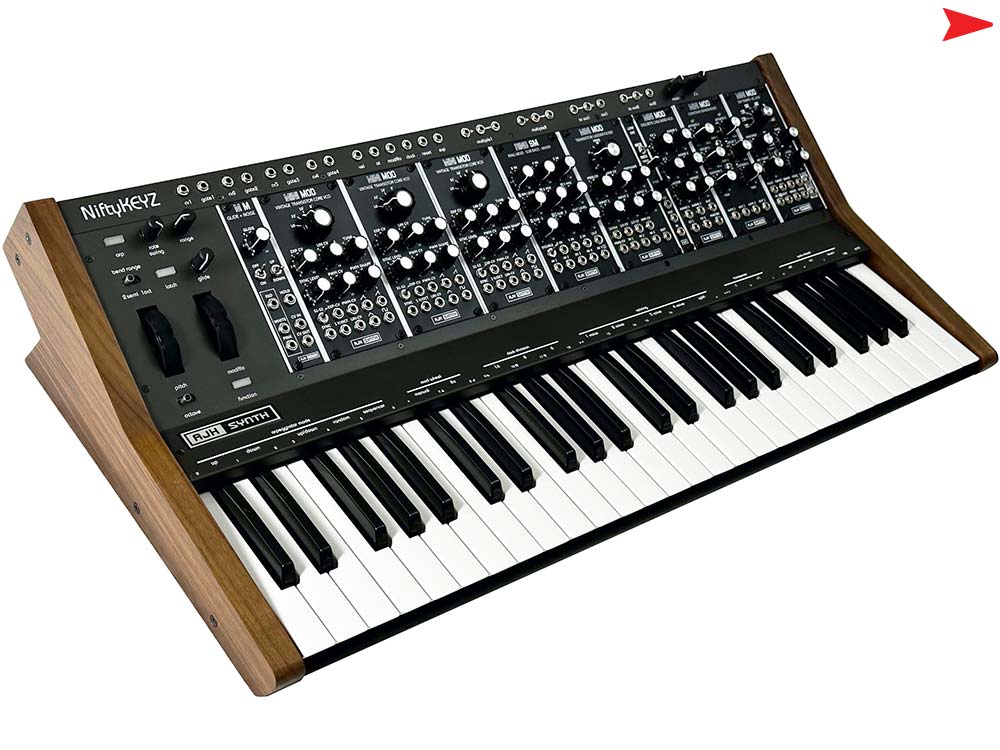AJH Synth has announced the MiniMod Keyz Modular Monosynth. The customizable MiniMod Keyz comes pre-installed with the MiniMod System modules. These are based on the original R.A. Moog version of the Minimoog Model D. But thanks to the NiftyKEYZ keyboard controller/case with American Walnut side-panels, the MiniMod Keyz features additional modules from Cre8audio.
If you’re not familiar with AJH Synth, they’re an analog Eurorack designer based out of the UK. The ready-to-play MiniMod Keyz modular monosynth contains a full-size 49-note, synth-action key-bed that outputs multiple pitch, velocity, and aftertouch CVs (control voltages), alongside a multi-mode arpeggiator.
AJH Synth MiniMod Keyz


The easiest way for electronic musicians to get their music onto Spotify, Apple Music, iTunes, Amazon Music, Tidal, Instagram, Facebook, TikTok, Pandora, Twitch & much more! Click the banner above or the Go Button to save 7% off of your signup! GO!
An Exciting Application Of Eurorack In A Keyboard Case
The MiniMod Keyz is centered around AJH Synth’s MiniMod System modules alongside additional modules mounted into a custom Cre8audio NiftyKEYZ keyboard controller/case, replicating the vintage circuitry and sound of the original R.A. Moog version of the Minimoog Model D in modular format with expanded functionality.
Arranged left to right is the MiniMod GLIDE + NOISE: glide (with added up/down function, including correct glide slope profile, and Hold function recreating glide-only-when-key-is-depressed behavior) and noise generator (with Red, White, and Pink noise CV modulation sources); 3x MiniMod VINTAGE TRANSISTOR CORE VCO: featuring the circuitry of the early R.A. Moog oscillator; Ring SM RING MOD – SUB BASS – MIXER: multifaceted module with a ring modulator (based on EMS’ Synthi/VCS3 discrete transistor design), two sub-bass generators — SUB -1 and SUB -2 — to add rich-sounding -1 and -2 octave waveforms with AJH Synth’s unique-shaped sine, and five-channel DC-coupled vintage Moog CP3 transistor mixer; MiniMod TRANSISTOR LADDER FILTER: directly based on the transistor ladder filter really representing the pinnacle of the early Minimoog Model D design; LOW FAT: voltage-controlled high-pass filter with 6 dB and 12 dB slopes for standalone use or in combination with the MiniMod TRANSISTOR LADDER FILTER to create a fully-customizable band-pass filter (allowing the range of pass bands to be assigned rather than fixed); MiniMod DISCRETE CASCADED VCA: an essential part of recreating the classic Minimoog sound since it also adds harmonic distortion and further character, directly based on a cascaded VCA (Voltage-Controlled Amplifier) that is actually two VCAs in series, as implemented in the very early R.A. Moog and Musonics Minimoog models with the highest distortion and most sought-after sound; MiniMod CONTOUR GENERATORS: faithfully reproducing all of the essential characteristics of the contour generators that are a major part of creating the classic Minimoog sound, including the exponential slope when used in conjunction with the (near) linear slope of the original VCA responsible for the famous Model D punch and unique re-trigger behavior (whereby multiple re-triggering increases the output level); and last, but not least, MiniMod TAP TEMPO VC-LFO: an extremely complex modulation source, specified to include a built-in VCA for CV control of modulation amount, TAP tempo and CV control of LFO (Low Frequency Oscillator) rate, 16 different modulation and random voltage waveforms (each with a unique PWM-style TWIST function), and clock in and out, as well as CV control of all parameters.
To showcase the power of this instrument, modules like the MiniMod TAP TEMPO VC-LFO, expand MiniMod Keyz’s capabilities above and beyond your typical modern Minimoog clone. After all, a considerable limitation of the Minimoog Model D design lies in its lack of any LFOs for modulation, OSCILLATOR-3 having to be switched from audio to LFO mode to provide modulation. As AJH Synth’s much-acclaimed MiniMod System benefits from Eurorack’s open architecture, adding LFOs into the mix made sense as a sound musical move — all the more so since Cre8audio’s NiftyKEYZ keyboard controller/case already features an onboard LFO hard-wired to its modulation wheel.
But by creatively combining its much-acclaimed modules with a Cre8audio NiftyKEYZ keyboard controller/case, AJH Synth has leveraged Eurorack’s open architecture for unlimited onboard patching and easy expansion. This MiniMod Keyz combo can just as easily connect to a DAW (Digital Audio Workstation) or other MIDI instruments and lends itself to live performance as a ready-to-play modular monosynth making use of the NiftyKEYZ keyboard controller with both velocity and aftertouch, CV outputs, five-mode arpeggiator with latch and sequencer mode, as well as swing and range control (allows arpeggiator span to be varied between one through to four octaves), onboard LFO that generates ramp, saw, triangle, square, or random waveforms; front panel octave switch (-1 / 0 / +1 octaves); transpose (up or down in semitones by up to one octave); selectable pitch bend range (+/- 2 semitones or +/- 1 octave); clock input and output; two active mults — multiple1 and multiple2 — for splitting CV and audio signals; switchable between gate re-trigger or legato — no re-trigger when second note is pressed — modes; dual outputs — out1 and out2 — with two to out1 and to out2 mix jacks, so four signals can be routed to the outputs; aftertouch and expression pedal smoothing (adding a glide to slowly increase the effect over time, selectable from 0 to 5 seconds); four pitch CV outputs — cv1 through to cv4 — and four gate outputs — gate1 through to gate4 — that allow for four-voice polyphonic modular control while the keyboard itself can be split into two zones; auto-chord function; five-pin DIN midi in and midi out/thru sockets in addition to class-compliant USB connection — CC #1 being routed to mod/lfo CV — for working as a fully-featured polyphonic MIDI controller for DAWs or other MIDI instruments; sustain pedal input (triggers arpeggiator latch function); expression pedal input (generates either a 0 to +5V or 0 to +10V range to the exp CV jack); two outputs — with both 1?4” and 3.5mm jacks — with separate headphone level control; and MIDI clock generated from internal arpeggiator, as well as receiving MIDI clock in.










